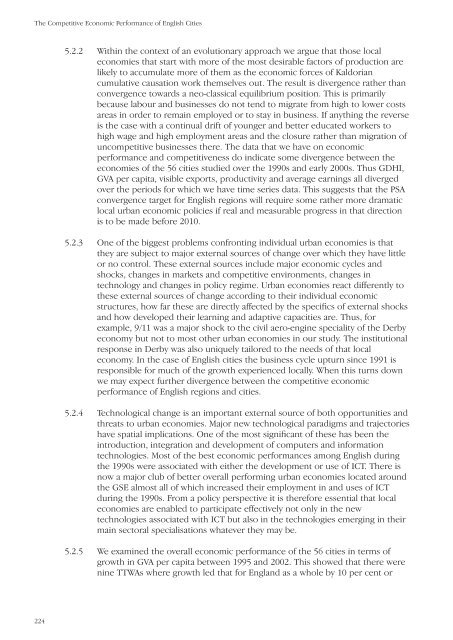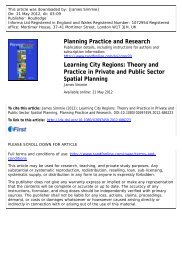The Competitive Economic Performance of English Cities
The Competitive Economic Performance of English Cities
The Competitive Economic Performance of English Cities
- No tags were found...
You also want an ePaper? Increase the reach of your titles
YUMPU automatically turns print PDFs into web optimized ePapers that Google loves.
<strong>The</strong> <strong>Competitive</strong> <strong>Economic</strong> <strong>Performance</strong> <strong>of</strong> <strong>English</strong> <strong>Cities</strong>5.2.2 Within the context <strong>of</strong> an evolutionary approach we argue that those localeconomies that start with more <strong>of</strong> the most desirable factors <strong>of</strong> production arelikely to accumulate more <strong>of</strong> them as the economic forces <strong>of</strong> Kaldoriancumulative causation work themselves out. <strong>The</strong> result is divergence rather thanconvergence towards a neo-classical equilibrium position. This is primarilybecause labour and businesses do not tend to migrate from high to lower costsareas in order to remain employed or to stay in business. If anything the reverseis the case with a continual drift <strong>of</strong> younger and better educated workers tohigh wage and high employment areas and the closure rather than migration <strong>of</strong>uncompetitive businesses there. <strong>The</strong> data that we have on economicperformance and competitiveness do indicate some divergence between theeconomies <strong>of</strong> the 56 cities studied over the 1990s and early 2000s. Thus GDHI,GVA per capita, visible exports, productivity and average earnings all divergedover the periods for which we have time series data. This suggests that the PSAconvergence target for <strong>English</strong> regions will require some rather more dramaticlocal urban economic policies if real and measurable progress in that directionis to be made before 2010.5.2.3 One <strong>of</strong> the biggest problems confronting individual urban economies is thatthey are subject to major external sources <strong>of</strong> change over which they have littleor no control. <strong>The</strong>se external sources include major economic cycles andshocks, changes in markets and competitive environments, changes intechnology and changes in policy regime. Urban economies react differently tothese external sources <strong>of</strong> change according to their individual economicstructures, how far these are directly affected by the specifics <strong>of</strong> external shocksand how developed their learning and adaptive capacities are. Thus, forexample, 9/11 was a major shock to the civil aero-engine speciality <strong>of</strong> the Derbyeconomy but not to most other urban economies in our study. <strong>The</strong> institutionalresponse in Derby was also uniquely tailored to the needs <strong>of</strong> that localeconomy. In the case <strong>of</strong> <strong>English</strong> cities the business cycle upturn since 1991 isresponsible for much <strong>of</strong> the growth experienced locally. When this turns downwe may expect further divergence between the competitive economicperformance <strong>of</strong> <strong>English</strong> regions and cities.5.2.4 Technological change is an important external source <strong>of</strong> both opportunities andthreats to urban economies. Major new technological paradigms and trajectorieshave spatial implications. One <strong>of</strong> the most significant <strong>of</strong> these has been theintroduction, integration and development <strong>of</strong> computers and informationtechnologies. Most <strong>of</strong> the best economic performances among <strong>English</strong> duringthe 1990s were associated with either the development or use <strong>of</strong> ICT. <strong>The</strong>re isnow a major club <strong>of</strong> better overall performing urban economies located aroundthe GSE almost all <strong>of</strong> which increased their employment in and uses <strong>of</strong> ICTduring the 1990s. From a policy perspective it is therefore essential that localeconomies are enabled to participate effectively not only in the newtechnologies associated with ICT but also in the technologies emerging in theirmain sectoral specialisations whatever they may be.5.2.5 We examined the overall economic performance <strong>of</strong> the 56 cities in terms <strong>of</strong>growth in GVA per capita between 1995 and 2002. This showed that there werenine TTWAs where growth led that for England as a whole by 10 per cent or224













